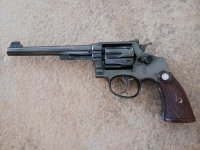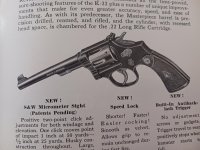Okay----------the early K-22 1st carries a rear sight with a single elevation adjusting screw-----the fifth in a series of similar sights, except that the screw is visible on top of the sight body. The previous renditions had the screw under the tang, accessible through a hole in the tang----the theory being the tension of the tang would prevent the screw from moving ("shooting loose")-----------not that there's much concern about .22 sights shooting loose, but these same sights were used on higher caliber guns-----and none of them completely eliminated shooting loose---nor did the single screw sight used on the early K-22 1st's.
The later K-22 1st's carried what is commonly known as the "two screw" sight----two screws at the aft end---both of which are employed in adjusting elevation, AND locking the sight in place---the first S&W sight that absolutely, positively will not shoot loose-------if/when properly adjusted and locked.
Proper adjustment and locking goes like this: Make the initial adjustment with the aft screw (get close). Make the final adjustment with the screw immediately in front of the aft screw. Now turn the aft screw counterclockwise as far as it will go. The screw is now locked in place by virtue of the fact the forward screw is pressing against the frame (top strap), and the aft screw is pulling against the frame via a flange nut with the flange riding in a slot milled into the top strap. This is clearly the very best sight S&W ever designed in that it won't shoot loose, AND it's infinitely adjustable for elevation, whereas the later "Micrometer" sight moves the point of impact a fixed amount for each "click" made by its adjustment screw------with no provision for finer adjustment. The adjustment on the "two screw" sight moves the point of impact 1" for each FULL turn of the screw, for each 10 yards of range. So much for the sights---except for stuck screws: Raise the rear of sight by whatever means are available-----a wooden or plastic wedge works well. Now given access to the sight channel underneath the sight tang, pour your favorite screw unsticker juice directly into the channel (Kroil is hard to beat!). With the gun fixed in a barrel down configuration, the penetrating oil has DIRECT access to the screw threads---rather than trying to find its way past the head of the screw on top----which can take DAYS----and a whole bunch of wasted super juice. This routine is, by the way, for unsticking the teeny-tiny little screw up front---the one fastening the sight to the frame. I've never encountered a stuck adjusting screw, although I reckon if you dropped the gun in the lake, and didn't bother taking it apart and cleaning/drying every single piece/nook/cranny, then you got exactly what was coming to you!!
Shooters or Collectibles? Yes---take your pick! You're not going to do any damage shooting them----never mind I wouldn't even think of doing it!
Value: I had two in my collection---only because one of them carried a King Cockeyed Hammer. They sold along with the rest of my collection in the past 3+ years as follows:
#659434, shipped January 28, 1937----$1750
#646192, shipped March 20, 1934----$2500----with the King Cockeyed Hammer---which cost $5.00 in the 1930's.
Ralph Tremaine
As an aside, pre-war sight screws (aside from the K-22 2nd's) are a pain in the butt because of the very small screws. That problem is easily overcome by Lowes Kobalt Precision Screwdriver Set, #0525844----their claim to fame being handles you can hold with your hands----rather than your fingers---which is the only game in town if you're using so-called Jewelers screwdrivers.
 (Consignment at my favorite local-ish gun shop).
(Consignment at my favorite local-ish gun shop). 


